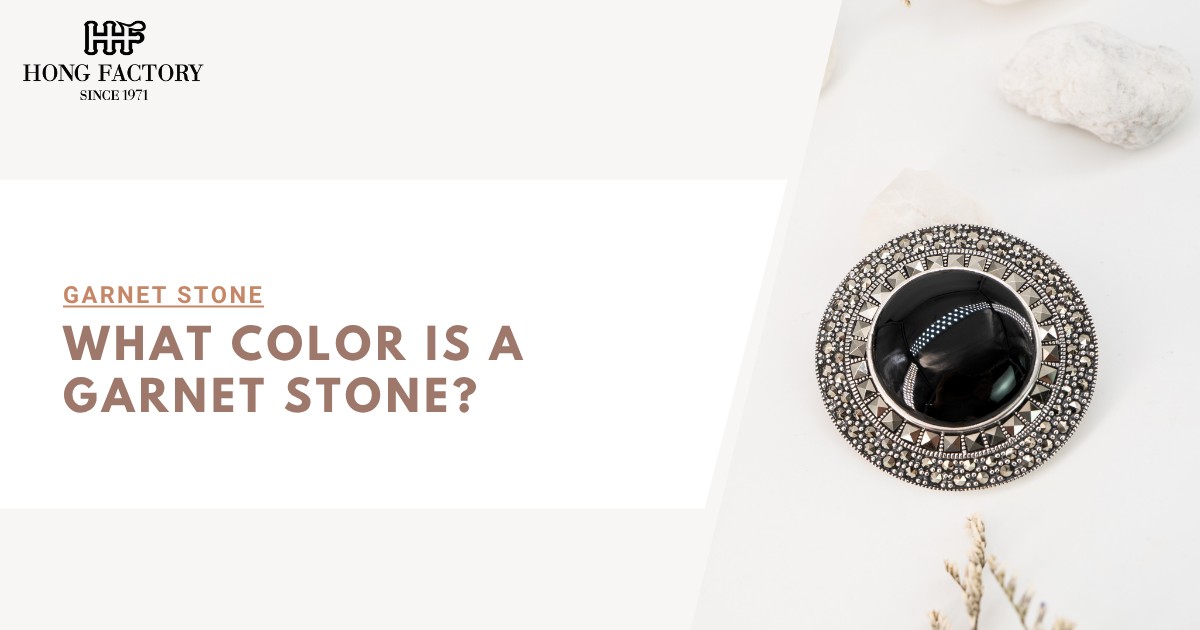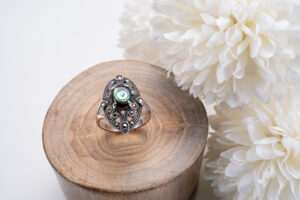
What Color Is a Garnet Stone?

Garnet is one of the world’s most captivating gemstones. Its rich colors, dazzling luster, and storied history make it a favorite in jewelry and gemstone collections alike. But ask, “What color is a garnet stone?” and you’ll discover that the answer is far more exciting and varied than many people expect. While garnet is most famous for its deep red tones, it comes in a remarkable rainbow of shades, each with unique appeal and significance. Let’s explore the beautiful world of garnet stone colors, the science behind these dazzling hues, and what they mean in the world of jewelry. marcasite jewelry
The Origins of Garnet Stones
Garnet is not actually a single mineral, but a family of closely related minerals that share a common crystal structure while displaying a variety of chemical compositions. This diversity is the reason behind the wide array of colors that garnet stones can possess. The name “garnet” is derived from the Latin word granatus (“grain” or “seed”), because many crystals resemble seeds of the pomegranate fruit.
Garnets have been prized since ancient times, used as talismans, decoration, and even currency. Ancient Egyptians, Greeks, and Romans all adorned themselves with these sparkling gems, most often in their classic red variety.
Garnet Stone – A Kaleidoscope of Colors
When thinking of garnet stones, most people picture a dark red gem the color most commonly associated with this mineral. However, garnet stones are found in nearly every color except blue, offering a remarkable palette for jewelry lovers and gemstone enthusiasts.
The Most Common Garnet Colors
- Red Garnet: The classic, ruby-like red is the most well-known garnet color. This shade is due to the presence of iron and chromium in the stone. Almandine and pyrope garnets are usually deep red or reddish-brown, often with a touch of plum or purple.
- Green Garnet: Tsavorite and demantoid are green varieties of garnet, colored by trace amounts of vanadium or chromium. These stones can range from a bright grassy green to an intense emerald-like hue. Green garnets are among the rarest and most desirable varieties.
- Orange Garnet: Spessartine garnets show a range of orange, from a fiery tangerine to golden, yellowish-orange. These stones are particularly eye-catching and are sometimes known as “Mandarin garnet.”
- Pink and Purple Garnet: Rhodolite is a popular garnet variety featuring stunning shades of rose pink, violet, or purple. Its gentle color makes it a lovely choice for feminine jewelry.
- Brown Garnet: Andradite and some almandines appear in earthy brown or bronze shades, representing another side of this gemstone’s diversity.
- Yellow Garnet: Some grossular and andradite garnets exhibit yellow or yellow-green colors. These are rare and offer a unique choice for those wanting something truly different.

The Science Behind the Color
A garnet stone’s color depends on its unique mix of minerals and trace elements. For example:
- Iron and chromium usually produce red, pink, and brown hues.
- Manganese can create orange and pink tones.
- Vanadium and chromium are responsible for the rich greens in stones like tsavorite.
As light passes through the stone and interacts with these elements, it reveals the gem’s signature shade. In some rare cases, color-change garnets can even appear different colors under varying light sources shifting, for instance, from green in daylight to reddish under incandescent light.
The Most Popular Types of Garnet Stones
- Almandine: Deep red or brownish-red; very durable and widely used in rings and necklaces.
- Pyrope: Pure, vibrant red; prized for its fiery appearance.
- Spessartine: Bright orange to reddish-orange, highly valued for its lively tone.
- Grossular: Ranges from green to colorless, yellow, or brown; includes the prized tsavorite variety.
- Andradite: Can be yellow, green (demantoid), or brown; notable for its brilliance.
- Rhodolite: Beautiful rosy pink to purple-red, often found in modern jewelry designs.
Symbolism and Meaning of Garnet Colors
The color of a garnet stone can influence its symbolic meaning. Traditionally, red garnet has stood for love, energy, and passion, while green garnet symbolizes growth, prosperity, and health. Orange and yellow garnets are often associated with creativity, joy, and confidence. Because they come in so many shades, garnets can be chosen to reflect a wearer’s birth month (January), personality, or aspirations.
How to Choose the Perfect Garnet Stone
Selecting a garnet for jewelry depends on more than just color preference. Keep these considerations in mind:
- Clarity and Luster: The finest garnets are crystal clear and have a bright, vitreous shine.
- Cut: Well-cut garnets, regardless of color, will display the best depth and brilliance.
- Durability: Garnets are quite hard and suitable for daily wear.
- Affordability: Most garnet stones are accessible in price, but rare types (like demantoid or tsavorite) can be more valuable.

Caring for Garnet Stone Jewelry
Garnet is a durable stone, but still deserves gentle care:
- Clean jewelry with mild soapy water and a soft brush.
- Avoid exposing garnets to harsh chemicals or sudden temperature changes.
- Store garnet jewelry separately from other gemstones to prevent scratches.
So, what color is a garnet stone? The simple answer: nearly every color of the rainbow, with the exception of blue. Red may be the most iconic, but the garnet family offers stunning options in green, orange, pink, yellow, brown, and more. This array of colors, coupled with a rich history and practical durability, makes garnet stone a top choice for anyone seeking beauty, variety, and meaning in their jewelry. Choose the shade that speaks to you, and let your garnet’s brilliance shine.




